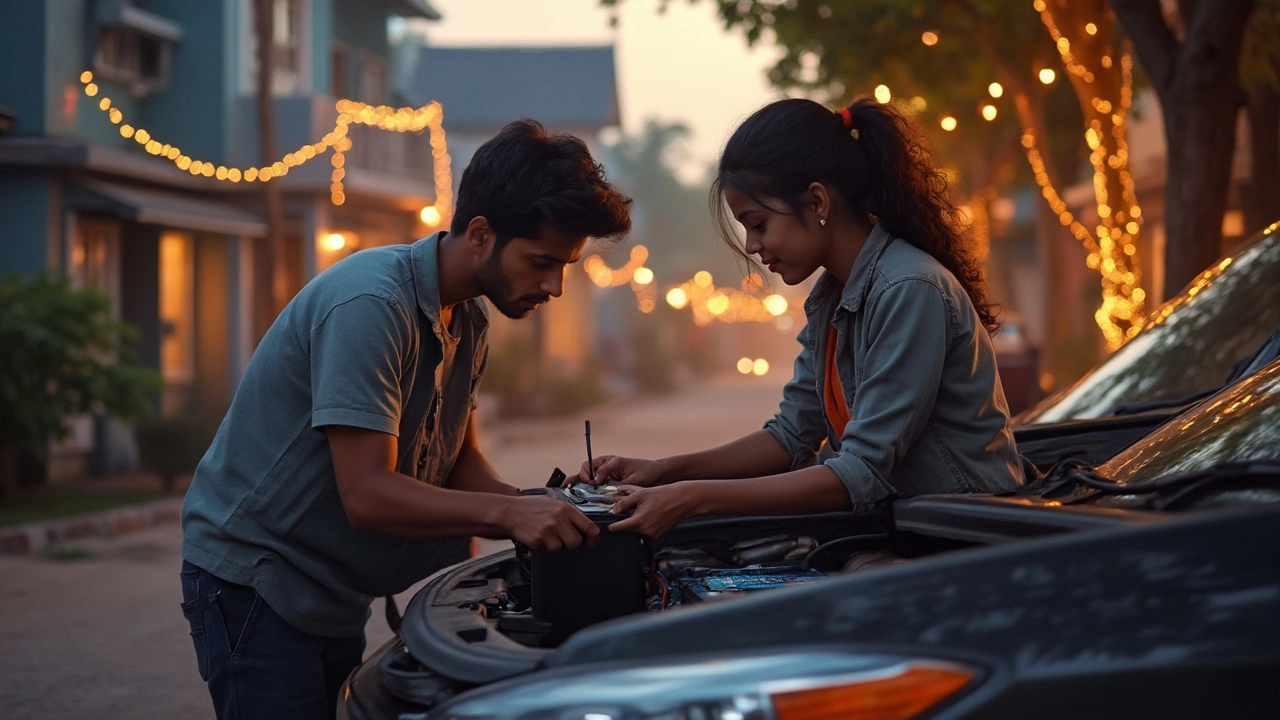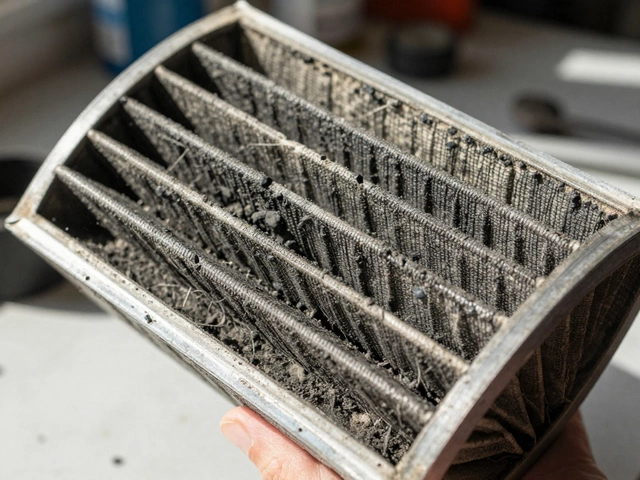
Ever wondered if changing your own car battery could save you a chunk of cash? You’re definitely not alone. With labor costs at auto shops on the rise, tossing on a pair of gloves and handling the swap yourself can look pretty attractive—but is it really worth it?
First off, let’s talk numbers. Typically, a professional installation might run you anywhere from $50 to $100 just for the service, on top of the cost of the battery itself. Now, if you’re savvy with your purchases, you might save some cash, especially if you've got access to discounted parts or know where to snag a good deal.
But hang on, before rolling up your sleeves, you'll need to grab a few tools. We’re talking about a wrench or two, likely a socket set, and maybe even some basic safety gear. It's nothing too crazy, but essential nonetheless. The good news? These are basic tools you might already have lying around the garage.
- Understanding Battery Costs
- Tools You'll Need
- Step-by-Step Installation
- Safety Tips
- When to Call a Professional
Understanding Battery Costs
Diving into the expense of buying a new car battery starts with the big question: Why are some batteries super cheap while others cost as much as a fancy dinner out? Several factors influence this.
Battery Types and Sizes
First, let’s consider the type and size of the battery. Most cars require a standard lead-acid battery, which are the most affordable, typically ranging from $70 to $120. However, if your vehicle runs on a more efficient AGM (Absorbent Glass Mat) battery, you might see prices jump up to $150 to $250. Not to mention, beefier batteries for trucks or SUVs can tack on an additional price.
Brand and Quality
Next up, brand matters—a recognized brand like Optima or DieHard often comes with a premium, reflecting their reliability and often longer warranties. These can save you money in the long run, but they’re not the cheapest option upfront.
Where You Buy
Where you buy your battery can also affect the price. Gas station convenience purchases tend to be pricier than snatching up a deal at your local auto parts store or online platform.
Warranties and Life Expectancy
When comparing costs, don’t sleep on warranties and battery life. A battery with a longer warranty might cost more upfront but can offer better value, covering premature failures for up to four or five years. Balancing the upfront cost and warranty details can help score the best cost-saving deal when comparing models.
Here’s a snapshot illustrating typical costs by battery type:
| Battery Type | Average Cost Range |
|---|---|
| Lead-Acid | $70 - $120 |
| AGM | $150 - $250 |
All these factors contribute to the final tag, so even though swapping out your car battery yourself can be a money-saver, it's crucial to weigh these variables before making a purchase. With this knowledge, you're more equipped to make a savvy choice that fits your ride and wallet.
Tools You'll Need
Alright, so you’ve decided to dive into the world of DIY car battery installation. Before getting down to business, you’ll need the right gear to make it happen without hiccups.
Basic Tool Kit
First on your list is a basic tool kit. Nothing fancy, but here’s what will come in handy:
- Wrench or Socket Set: Your battery terminals might require different sizes. Commonly, a 10mm wrench will do.
- Screwdriver: Sometimes necessary if your battery's held in place with a bracket.
- Protective Gloves: Batteries can have some corrosive gunk, so protect your skin.
- Safety Goggles: Just in case you’ve got any acid splashes - better safe than sorry!
Specialty Items
Depending on your car's make and model, a couple of specialty tools might be needed:
- Battery Terminal Cleaner: To clean off any corrosion. Not a must, but highly recommended if you have some buildup.
- Multi-Meter: To double-check your battery's charge. Useful to confirm the diagnosis before shelling out on a new battery.
Where to Get Them?
Most of these tools can be snagged at any local hardware store or purchased online. It’s budget-friendly if you don’t already own them, often costing under $30 combined.
Making sure you have the right toolkit is crucial for a smooth install. The last thing you want is to be halfway through and realizing you’re missing a critical piece!

Step-by-Step Installation
Alright, if you're ready to dive in, let's walk through the process of changing your car battery yourself. Doing it right the first time will save both time and headache. So, grab your tools, and let's get to work!
1. Gather Your Supplies
Before anything else, ensure you have all the necessary tools: a wrench set, safety gloves, and, of course, your new battery. Safety first!
2. Find Your Battery
Pop open the hood and locate your battery. It’s usually housed in the engine bay but remember some vehicle models, like certain European cars, have it in the trunk.
3. Disconnect the Cables
- First, use your wrench to loosen the nut on the negative (black) cable. Remove it and tuck it safely away from the battery. This is crucial to avoid sparks.
- Next, do the same for the positive (red) cable.
4. Remove Old Battery
Batteries are heavier than they look! Before lifting, check for any hold-downs or brackets securing it. Use your wrench to remove these.
5. Install New Battery
- Carefully place the new battery in the tray, making sure the terminals align properly.
- Secure it with any brackets or hold-downs you removed earlier. Don’t let it rattle; vibration kills battery life.
6. Connect the Cables
- Start by connecting the positive (red) cable first. Tighten the nut so it's snug but not overtightened.
- Repeat for the negative (black) cable. Once done, double-check everything is tight and in place.
7. Test It Out
Now, start your car. It should ignite like a charm. If not, check the cable connections and try again. If nothing happens, it's time to re-evaluate the battery or call in a pro.
Voila! With these steps, your DIY car battery installation should be successful. This not only saves you money but gives a sense of accomplishment. Plus, it’s a great entry into vehicle maintenance if you’re diving into the world of auto repairs.
| Professional Installation Cost | DIY Cost | |
|---|---|---|
| Service Fee | $50 - $100 | $0 |
| Battery Price | $100 - $200 | $100 - $200 |
| Total Cost | $150 - $300 | $100 - $200 |
Safety Tips
Switching out a car battery is no small feat, and it's important to prioritize safety over speed. After all, these guys pack a punch, with enough voltage to give you quite a shock! So, let's keep it safe and sound.
Gear Up Before You Go
Before you start, make sure you're dressed for the part. Don’t forget those gloves and goggles. They're your best friends when it comes to avoiding acid burns and unexpected sparks. Some folks even like to toss on a long-sleeve shirt and wear pants to cover exposed skin, just in case.
Disconnecting the Battery
Here's a crucial step—disconnect the battery the right way. Always begin by removing the negative cable first. This avoids accidental grounding and prevents short circuits. After that, move on to the positive cable. Don't flip the order, or you might end up in for a shock, literally.
"Safety with vehicle maintenance begins with understanding and respecting the power you're working with," reminds Jane Doe, a seasoned auto technician. "A small mistake can lead to a big problem, so always double-check what you're doing."
Handle With Care
Once the DIY install is in progress, remember to keep the battery upright. This keeps the acidic contents from leaking out. If you spot any corrosion on the battery terminals, handle it with care. You can use a mix of baking soda and water to safely clean it off.
A Few Don'ts to Keep in Mind
- Don’t smoke or bring open flames near the battery, as batteries can emit flammable gases.
- Keep metal objects like tools or jewelry away from the battery terminals to avoid accidental short-circuiting.
- If you ever feel uncertain, it’s totally okay to hit pause and call in a pro. Better safe than sorry!
With these simple but effective safety tips, you’ll reduce the risk of mishaps and keep your DIY car battery change smooth and drama-free.

When to Call a Professional
So, you've decided to go the DIY route with car battery installation. But wait! Sometimes it's smarter and safer to bring in the pros. How do you know when to call in backup?
Complexity of the Installation
Most cars make it easy to swap out a battery, but some newer models are a bit trickier. Certain vehicles have the battery tucked away in hard-to-reach spots like under the seat or in the trunk. If you find yourself climbing over things or trying to remove half your dashboard for access, it might be a good time to call a professional.
Signs of Electrical Issues
If your car's electrical system is acting up—like flickering lights or odd sounds when you try to start—it’s not just about the battery. Electrical problems can be a headache and downright dangerous if ignored. It's probably best to have a professional check out what's really going on to avoid bigger issues down the road.
Lack of Tools or Experience
Got the right tools for the job? If not, hiring a pro can prevent buying a toolkit you'll use once. Also, if you're not comfortable with the process or it's your first time under the hood, peace of mind often trumps the small amount you'd save.
Battery Type and Calibration
Some car batteries need special handling or calibration once installed. Advanced systems sometimes require a diagnostic tool to reset everything properly. Messing this up could leave you worse off than when you started.
| Factor | Reason to Call a Professional |
|---|---|
| Access Difficulty | Battery in a hard-to-reach location |
| Electrical Problems | Symptoms beyond a dead battery |
| Tool Requirement | Lack of necessary tools or experience |
| Calibration Needs | Special handling required post-installation |
No shame in getting some help when you need it. A professional can save time, prevent frustration, and ensure your battery replacement is a one-time thing rather than a DIY saga.





